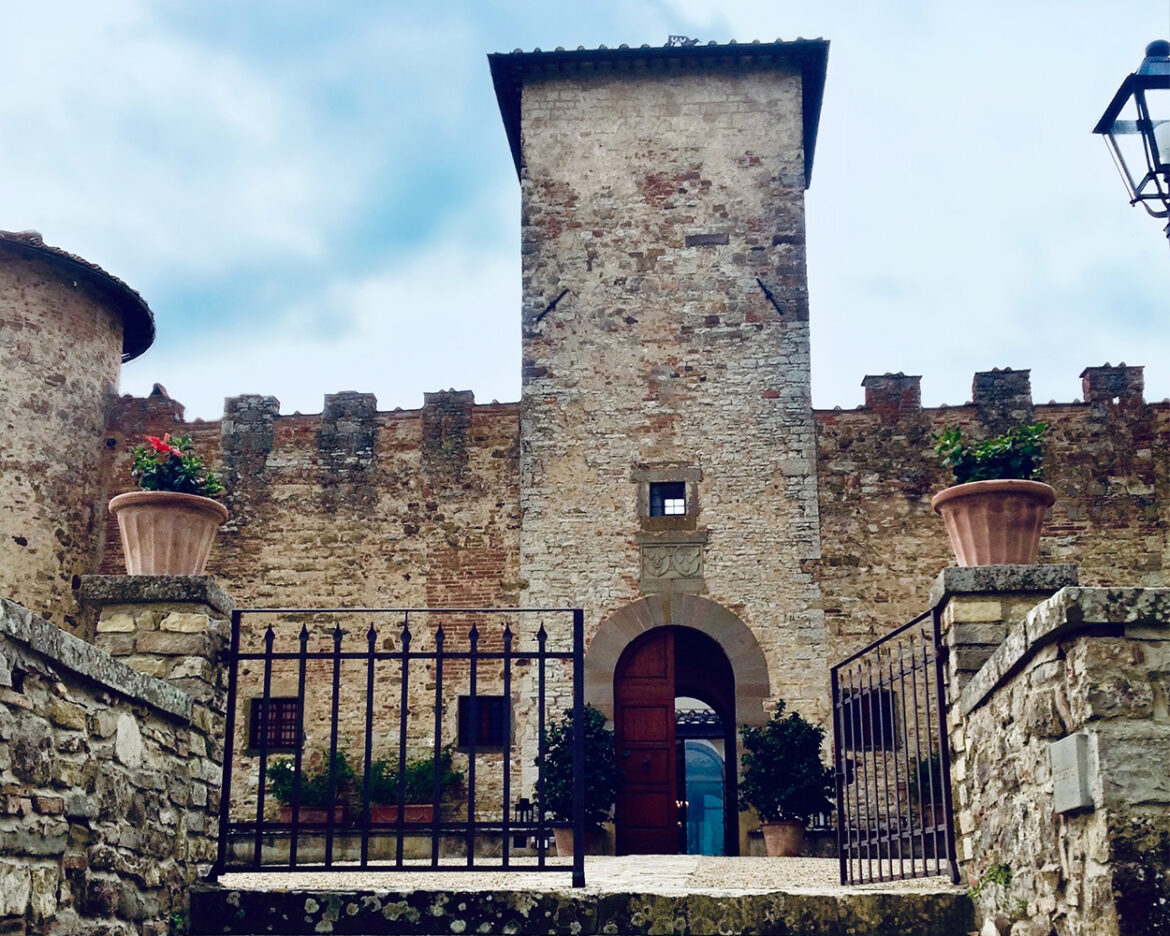I was collected at the Florence airport by a stocky man in his late fifties.
“Parla inglese, signore?” I asked, as he slung my bag into the trunk.
He smiled. “No — a leetle.”
I apologized for my own meagre Italian. “Il mio italiano è molto semplice.”
“Va bene!” he boomed, unconvinced. My accent is better than my vocabulary.
Once we’d made our way out of the airport’s labyrinth, I tried to make small talk. “Lei é Fiorentino?” I knew this might unleash a torrent of undecipherable Italian, but it’s polite to ask where someone’s from, especially in Italy, where from-ness is existential.
“Si, si,” he said, before launching into a lengthy disquisition on the complicated genealogy of his mother’s forbears.
As the Tuscan landscape sped by, we entered a forested area, passing signs for deer crossings. I asked him about caccio — hunting.
“Bang, bang! Bambi!” he crowed. He asked me for the right word, repeating “deeeer” aloud to remember, while I learned the Italian, capriolo. I was reminded of my father venturing into dark November mornings to return much later, when it was dark once again, with a deer for our own larder.
Do you also hunt wild boar, I asked, “Anche i cinghiali?”
He lit up, fumbling for his flip phone in his back pocket, half a hand on the wheel and half an eye on the serpentine road. He poked his device’s minuscule buttons with his blunt fingers. “Ecco!” he said, jabbing the phone toward me as the car lurched and careened.
On its tiny screen I could see a picture of a boar hanging from a tree, post-hunt. I praised his handsome prize as he began to detail his animal’s particulars, its length and girth, its weight. He seemed to be saying it weighed three hundred kilos. Might he have said thirty, or thirteen? I was too addled by jetlag to be sure, much less wrap my mind around a 600-pound boar. Could I have heard it wrong?
Some people find it too — something, he told me. I didn’t know the Italian, but it seemed clear he meant gamy, wild tasting. His sister doesn’t care for it, for example. But long cooking tames and sweetens the meat. First, boil it for a few hours, then braise it for a full day. It seemed more a recipe for rubber bands than dinner. He smacked his lips.
I must have heard it wrong.
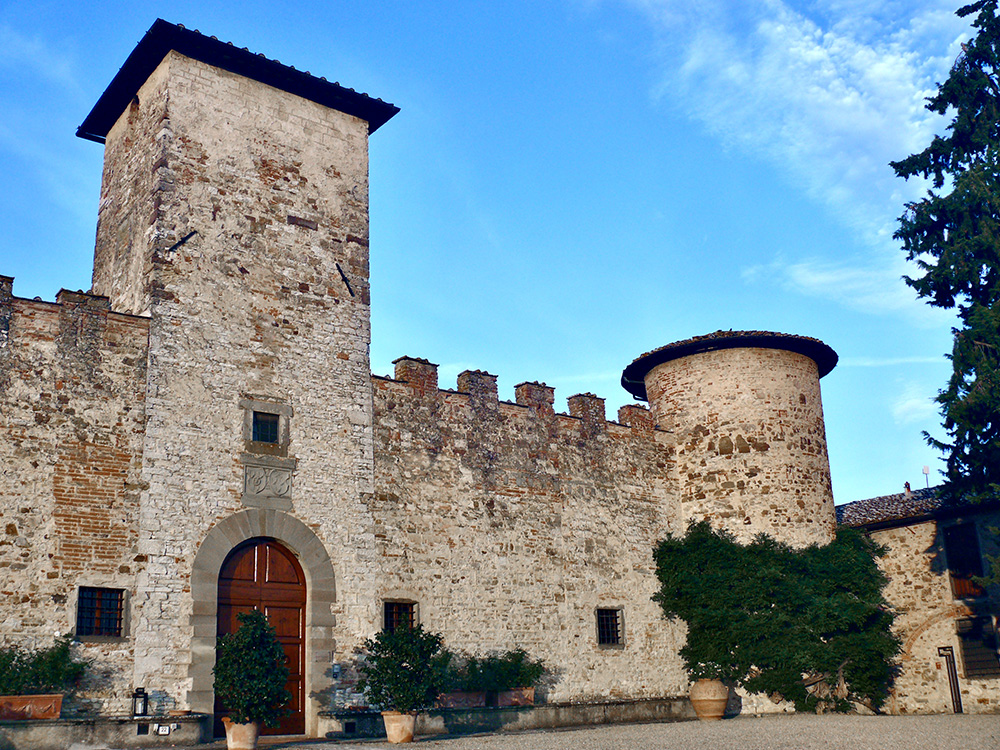

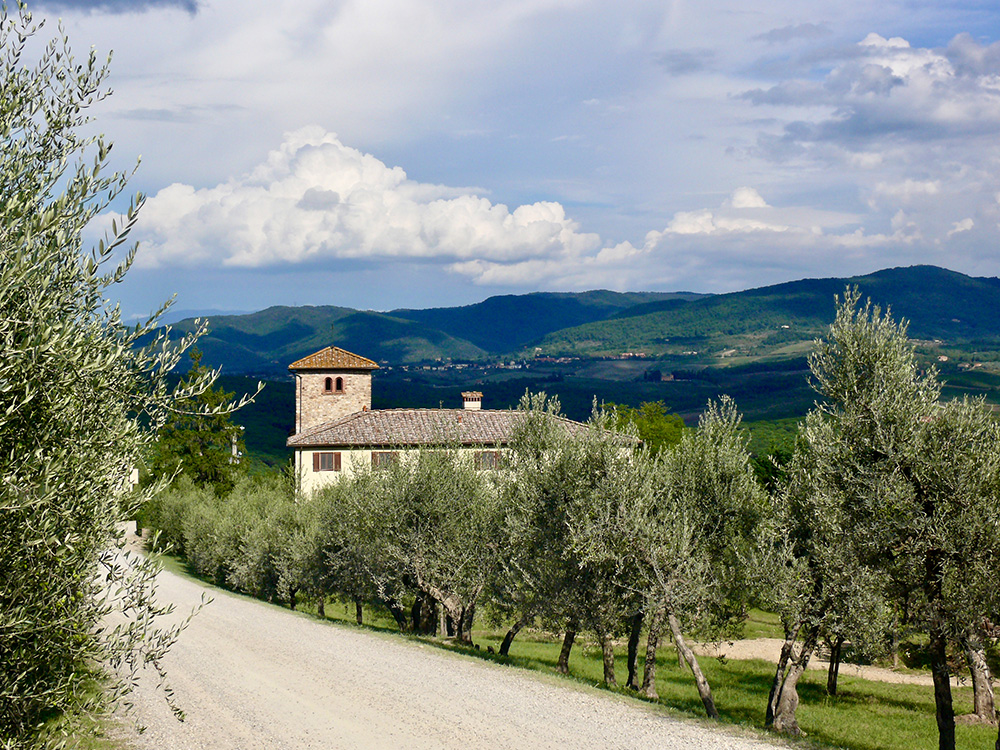
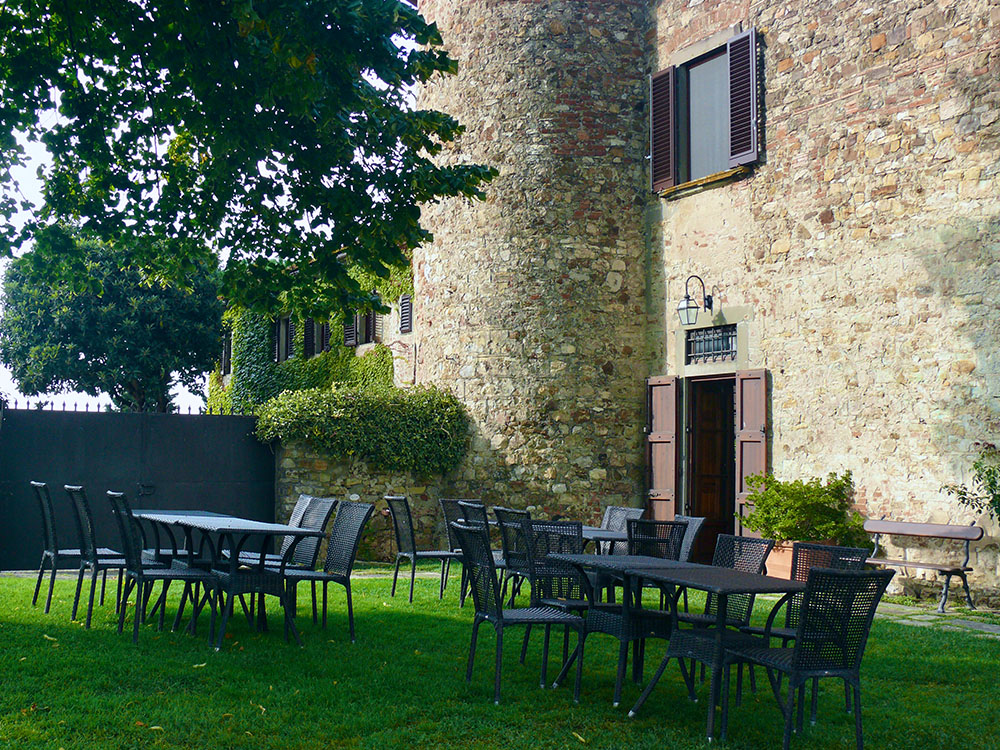
We pulled up the drive at Castello di Gabbiano, passing rows of olive trees and vines, the gravel crunching beneath our wheels. We parked by the front steps, the car a shiny anachronism.
Gabbiano is a proper castle. It was erected in the 12th century to watch for marauding Sienese and collect tariffs from passing traders. Its founder named it for himself, Fundus Gavianus, “Gaviano’s land.” This was a period of growth in Florence, ruled then by nobles but with an accelerating merchant class. Many new towers and churches were being added to the Florentine cityscape, and the perimeter walls were pushed back to make room for the growing populace.
Beginning in the 13th century, the Bardi family, bankers from Florence, took up residence in Gabbiano, adding a perimeter wall and ramparts. Two centuries later, the property passed to the Soderinis, another politically powerful clan of Florentines. Documents from 1464 describe it as a farm keeping animals, growing fodder, curing meats, making cheeses, pressing olives, and producing wine in the cellars beneath the stone leviathan.
In the 16th century, at the height of the Renaissance, the castle belonged to Piero di Tommaso Soderini, an influential statesman who served for a time as the ambassador to the Kingdom of France. Political upheaval led to his falling out with the Medicis, and Soderini was exiled to the Dalmatian coast.
When his successors were at last able to return, a century later, they added four cylindrical stone parapets to complete the look we see today. They also mounted a plaque above the door publicizing their restoration, completed in 1652: “FRANC. SODERINUS SENAT.GASP.F.RURIS HUIUS IN FAMIGLIA RESTITUTOR SUB.A MDCLII.”
Over the next few centuries, ownership paced through a succession of important Florentine families. All continued producing wine. The main building saw few structural changes beyond modernizations to plumbing and wiring, but small farmhouses were built to house workers, and the estate gradually came to feel more like a tiny hamlet than a lone castle on a hill.
In 1970, an Italian chemist named Rino Archaini bought Gabbiano and began to improve the vineyards and winemaking. He added a modern facility to the ancient cellars and built an export business until finally, in 2000, he sold the entire property to his U.S. importer, Beringer Wine Estates. Beringer was soon absorbed into Foster’s Group Ltd., an Australian brewer that had been expanding its presence in global beverage alcohol, and within a decade Fosters had spun off its wine business as Treasury Wine Estates. Today, Treasury is a publicly traded colossus with nearly $2 billion in annual revenue. They still own Gabbiano. They did not mount their own sign over the door.
These mergers and acquisitions rattled longtime employees of Gabbiano, some of whom had raised their families in the estate’s farmhouses. But Treasury decided to preserve the smallholder vibe, and while a portion of the fortress was converted into a hotel and one of the farmhouses into a restaurant, many of the workers remained.



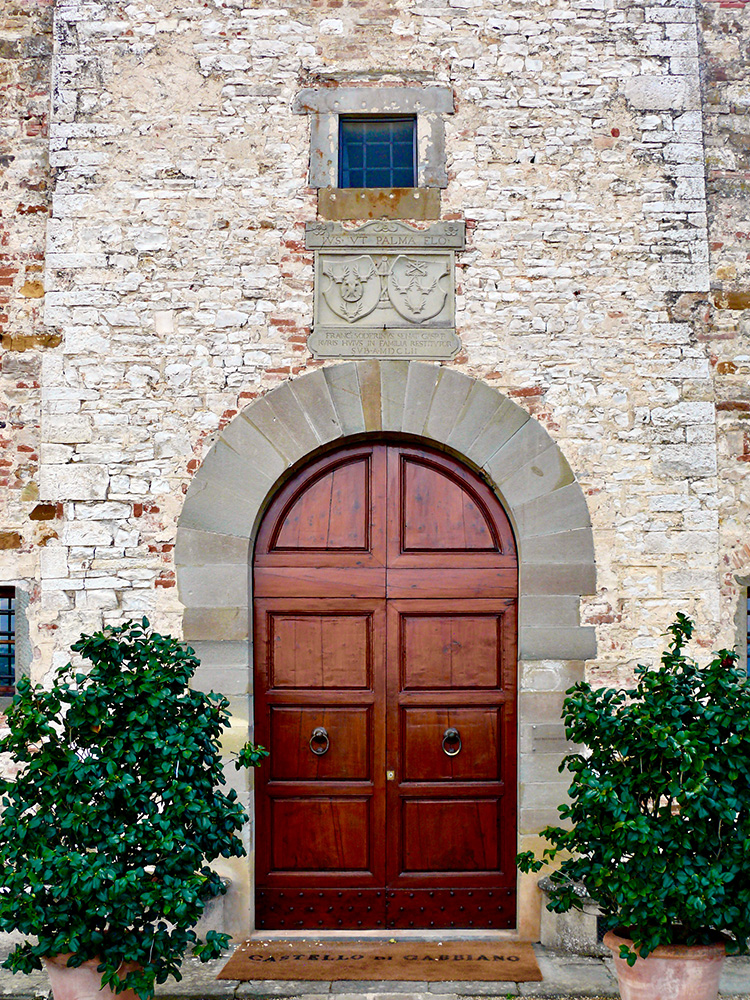
The hotel is quirky. Cell coverage is negligible, and Wi-Fi soaks into the castle’s foot-thick walls. The rooms lack televisions and there is no room service. There is, however, a fine breakfast of charcuterie, breads, cheeses, house-made conserves, and fruit so ripe it’s decadent, which you can take in the quiet cathedral of the breakfast room or outside under the cypress. There is also a grand ballroom with a clutch of couches, a serene library (with the only reliable Wi-Fi), and a swimming pool with a view of the Tuscan hills.
My room was on the second floor of the original donjon. Up a short flight from my bed chamber was a tidy modern bathroom, and farther still, via spiral stair, a small sitting area. On the landing between these was a square window braced with iron bars, which, I discovered, was directly above the castle’s entrance and that ancient stone inscription. I could rest my elbows to watch the business of the day, doors thundering below me with each passage.
From Gabbiano’s terrace, the landscape falls away, green and undulating, scumbled with forest and vineyards and dotted with blocks of habitation. Across these rippling valleys the land rises up again, and in the blue distance, pierces the sky with poplar trees and yet more stone towers. It feels as if the landscape tips back toward you like a mirror, reminding you that you are not alone, you are both seeing and being seen, watching and being watched.
This is the wine territory now called Chianti Classico. Named regions are a relatively modern idea, designed to codify, in legal and practical terms, the grapevines, yields, blending and aging protocols, and all the other minutiae that go into making a bottle of wine. In the old days, people made wine with whatever vines they had. Around here, in 1000 B.C.E., the vine was Vitis vinifera sylvestris and the people were the Etruscans, who harvested grapes from wild vines twining up trees, stomping them in stone troughs and aging the wine in clay.
As trade and conquest began to change the social contours of the region, new vines were introduced from the Mediterranean basin and beyond. They wound their way into native vineyards and native vine genetics. Sangiovese, the modern vinous king of Tuscany, is one of these alloyed grapes, the offspring of a crossing of Ciliegiolo, which appeared in the region as early as the Middle Ages, and Calabrese di Montenuovo, introduced from the southern reaches of the Italian peninsula.
Contemporary wine scholars are indebted to another member of the Soderini family, Giovan Vettorio Soderini, who, like his relation Piero, also had a spat with the Medicis that resulted in his banishment. While in exile, he devoted himself to the study of vines and wines, publishing, in 1600, a treatise on viticulture. He was first to name the Sangiovese grape, from sanguis Jovis, “Blood of Jupiter.”
For centuries, Tuscan wines were blended wines, in part for balance and in part for parsimony, because people made wine out of whatever they had, and what they had was a mix. Sangiovese delivered structure, Canaiolo softened edges, and Colorino boosted color. White grapes were also included in the blend, principally Trebbiano Toscano and Malvasia. These bulked up volume (at the expense of ageability) and made it a lighter-weight quaff. Toward the end of the 19th century, producers decided that Sangiovese should be the focal point of the blend, but the use of white grapes persisted, and actually were required until 1996. It wasn’t until 2006 that they were, at last, forbidden.

In the mid 20th century, Italy’s system of sharecropping (mezzadria) succumbed to social and political pressures. This drove agricultural workers from the countryside into northern factories in Milan, Torino, and Genoa, or to nearby cities of Florence, Siena, Pisa, and Livorno. Vineyards were necessarily mechanized, and for many producers the focus was on quantity over quality. The wines were dull, but at least they were cheap.
Toward the end of the century, producers and their consortiums grew eager to re-establish Chianti as a fine wine. They introduced new regulations and encouraged modernizations in the vineyard and cellar. Many abandoned aging in large casks, or botti, in favor of small barriques that would make the wine appeal to international palates. In the blend, Merlot, Cabernet Sauvignon, and Syrah began to squeeze out natives Colorino and Canaiolo. These gestures scrubbed away Sangiovese’s earthy, savory signature, replacing it with a fully modern sensibility: ripe, plush, kissed with oak. The wines were dull, but at least they were expensive.
Today’s Chianti Classico wines are postmodern. Producers use a mix of contemporary and historic practices. Fermentations might happen with temperature control in stainless steel, but then the wine may age in historic botti, softening it without adding oak flavor. Producers might use hand harvesting for top plots but stick to mechanical harvesting for lesser cuvées. International varieties continue their presence in the blend, but in practice much Chianti Classico is a varietal wine, or has only a small fraction of other grapes. Bottles are subjected to tasting by Consorzio panels to earn DOCG status and the right to sport the legal seal on the capsule. That practice stifles creativity but does ensure stylistic consistency.

After settling into my room, I sat for dinner at the hotel restaurant, il Cavaliere, with Ivano Reali, Gabbiano’s managing director, his wife, Cornelia Lehner, the director of hospitality, and a handful of other journalists who’d come in for the harvest tour.
I ordered braised cinghiale, Tuscan wild boar. How could I not? It was earthy and tender, darkly savory. The chef, Federico Berardinelli, stopped by our table to say hello. Berardinelli is tall, with dark eyes and an amiable face that sometimes sharpens into focus.
I asked about his cooking technique and described my driver’s recipe. “Is it gamy, or tough?”
“Not really,” he said. “But it is important to braise it so that its muscle fibers start to soften. People often don’t braise it long enough for the collagen and connective tissue to melt,” he said. “But no, not twenty-four hours.”
After he retreated to the kitchen, the talk turned to wine pairing. “The food is made to accompany the wine,” Cornelia announced, almost unbidden, in her light Swiss-German accent.
I wondered if she was being purposely provocative. The more common catchphrase runs in reverse: the wine is made to accompany the food.
“Here’s an example,” she said. “When you ask at the market for Prosciutto, the butcher asks, ‘Dolce, o salato?’ Sweet, or salty? Tuscan Prosciutto is salty and spicy. It perfectly matches Chianti. Meanwhile in Parma, the Prosciutto is sweet, and the wines are softer, made from Barbera or Bonarda. San Daniele Prosciutto is buttery, and the wines are white — the Friulian whites. In Alto Adige, the Prosciutto is smoked, and the wines are spiced, like Gewürztraminer.”
She smiled with an air of finality.
“But, couldn’t all of that have come about the other way around?” I said. “People make softer wines to go with their sweeter Prosciutto, people make Gewürz because it’s great with smoky food?”
“Think about Tuscan food,” she said. “It’s savory, and it’s heavily salted. It makes a big impression, so it complements wine with a lot of structure and body, like Sangiovese. The wine came first. The food followed it.”
“I guess I think of it as a co-evolution,” I said. “We have these grapes, these plants, these animals, the stuff that nature hands us. How does one season the other?”
Chianti Classico was unquestionably a terrific pairing for the boar. Not to mention other classic Tuscan foods: Bistecca, ribollita, pork, game, lamb. The cuisine is boldly flavored, which is why Tuscan bread is not salted; so it can serve as a neutral counterpoint.
Still, “wine first” was an altogether new notion to me, and after retiring to my room I kept wondering about it. I couldn’t shake the image of co-evolution, a conversation between plate and cup co-created by those who make the meal.
But perhaps Cornelia’s thesis could obtain in regions with long-standing and highly characterful grapes: Sangiovese in Tuscany, yes, but also Nebbiolo in Piemonte, Nerello in Sicily, Greco in Campania. Vines that have hung around a site for a thousand years have established themselves as an enduring flavor, an enduring archetype. Tinker at your peril.
It might be simply a matter of botany. Many of our food crops are annuals, and some can turn to flower and fruit and seed even faster (I’m looking at you, radish). That means the raw materials can evolve quickly and precisely as humans rapidly develop new cultivars. It also means that when cooks brush up against new cultural influences, due to migration or trade or other jostlings, they can swiftly introduce novel plants and ingredients into their kitchens. It doesn’t take long for new foods to get a toehold.
Meanwhile the vine is a perennial woody plant, unproductive for its first four years and only hitting stride after a decade. After that it crops annually, but unlike a pumpkin or a head of lettuce, wine isn’t ready right after at harvest; it must be aged. Wine does of course evolve — we see that everywhere wine is made — and people are always hastening its evolution. But that evolution is necessarily slower, which means wine can’t learn as fast as food learns. When one must flex, the food is more bendable.
Another way to say it: We season food with new ideas but serve it with wine from our grandparent’s cellar.
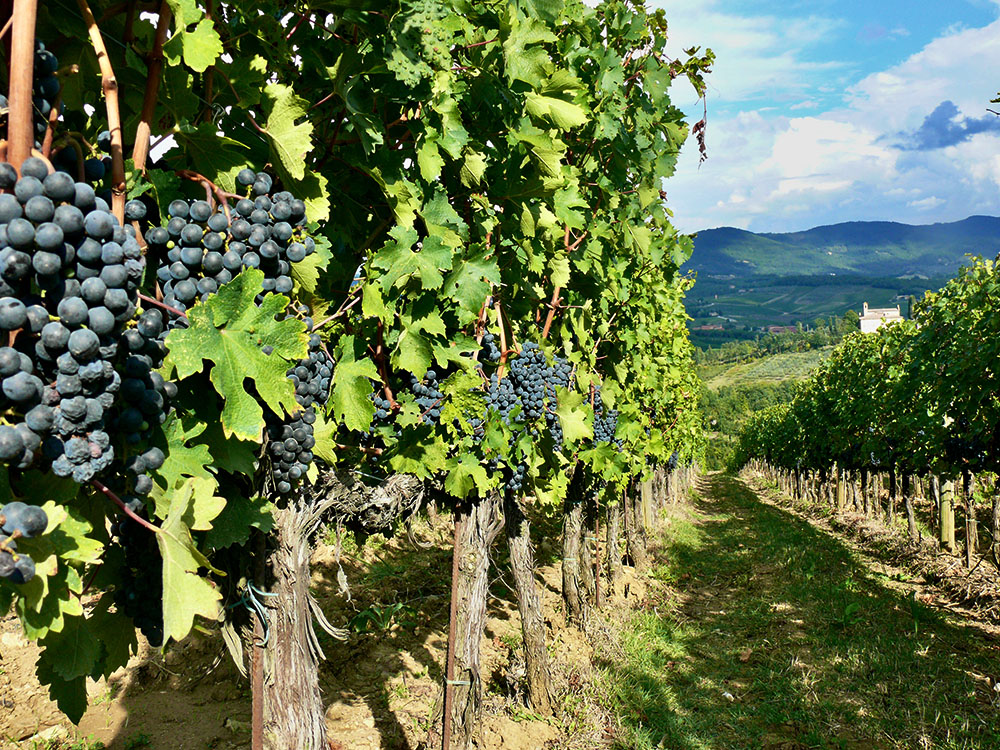

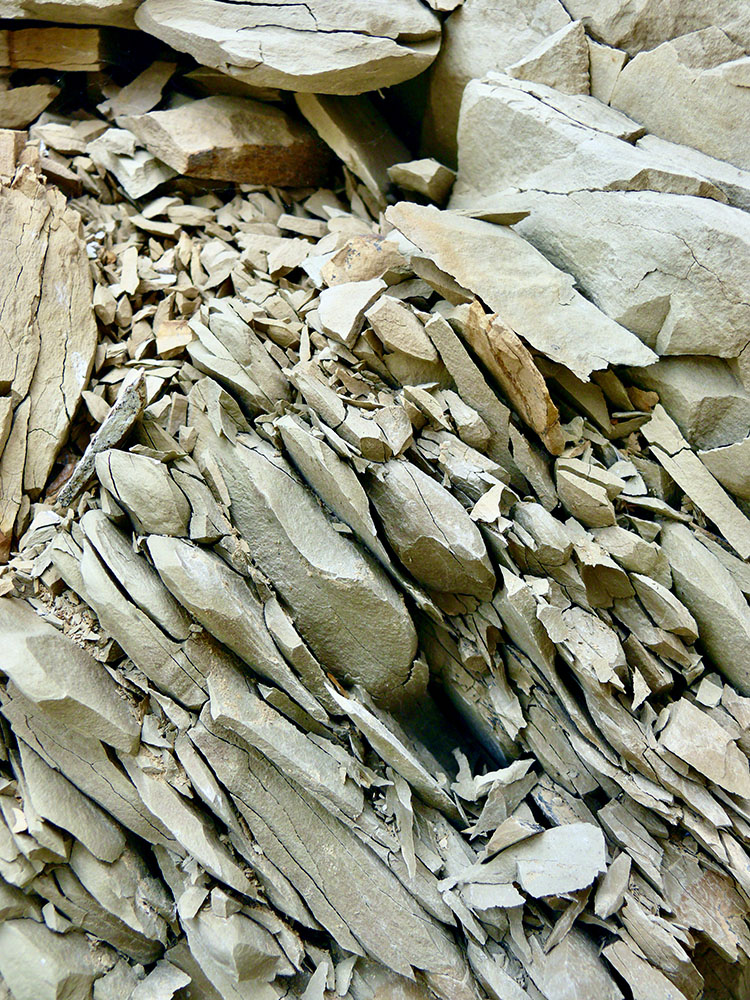

The next day I trekked into Gabbiano’s vineyards with their viticulturist, Francesco Caselli. Silvia Bottelli, the marketing manager coordinating the tour, also came along. Stones beneath our feet shattered into thin layers. The castle is ringed by topsoil rich in calcium, clay, and marl, with chunks of flaky, friable shale the locals call galestro. The composition drains well but paradoxically also holds moisture, easing drought stress during summer heat. Sangiovese, a picky grape, likes galestro’s soothing effects, but it also thrives in the limestone-rich albarese soils that blanket other Tuscan hills.
Gabbiano, or rather Treasury, owns a total of 147 hectares in Tuscany, including 107 in Chianti Classico. There are 70 surrounding the castle. Caselli waved his arms around the hillside, pointing out where the top wines are grown. In addition to Sangiovese, this estate also has Merlot and Cabernet Sauvignon.
Chianti Classico has most recently been divided into eleven geographic units, Unità Geografiche Aggiuntive, or UGAs, to recognize distinctive personalities from different areas. These names are currently only allowed to appear the labels of the top Chianti Classico wines, called Gran Selezione, although over time permission will almost certainly extend to the two other typologies, vintage and reserve. A UGA is about more than geology. It is a signifier of territorio, meaning not just territory but territoriality, the matrix of factors that also include identity, typicity, and historicity. It’s another example of how wine is always reinventing itself, or rather, how we are reinventing it.
Caselli and his crew have been steadily replanting here with newly developed Sangiovese clones. Older clones had tight clusters and thin-skinned grapes, making them prone to rot during wet periods. They also cropped heavily, yielding a wine light in color and low in flavor. The new clones address many of these concerns. They have smaller berries and thicker skins, and open clusters that allow air to flow through. Their higher skin to juice ratio yields a darker, more flavorful wine.
A crew of 40 people is employed at Gabbiano year-round. As soon as the grape harvest is finished, in October, they begin the olive harvest. After the new year, they get to work on pruning. They do some mechanical harvesting, using a contraption with adjustable paddles that shake the berries into a hopper. Some portions of the vineyard had already been gathered this way, bare stalks dangling from the battered canes. Caselli explained they don’t harvest their top vines this way, but for their lower-cost wines it’s their only option. “One machine can harvest four hectares in a day,” he said. “By hand you need fifty people.”
He said they were seeking to purchase additional plots to expand production, with their eyes set on planting yet more Sangiovese.
“What do you look for when acquiring land?” I asked.
“The boss” — that’s winemaker Federico Cerelli — “says what kind of wine needs to be made, and for which labels. Then we look for plots that meet the requirements.”
“That’s because 80 percent of the wine is made in the vineyard,” Silvia added.
“Only 80 percent?” I said. She had just substantially discounted one of wine’s most hackneyed maxims.
“Don’t tell the winemaker,” she chortled.
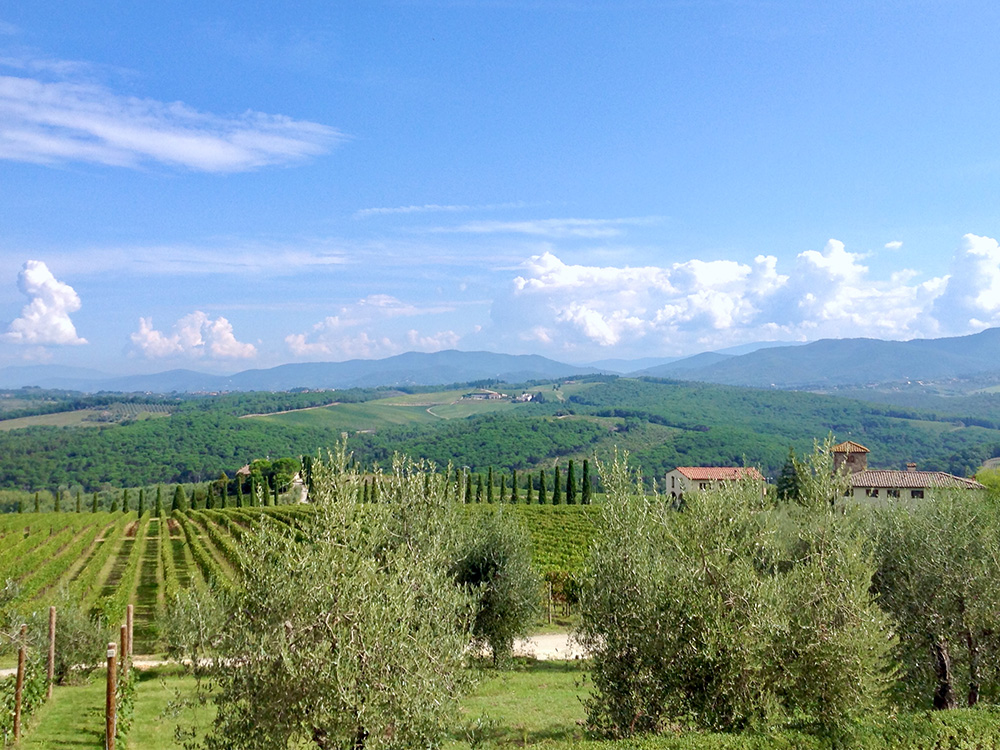
I joined winemaker Cerelli for a tasting in the cellars beneath the castello. The temperature and humidity of the vaults are smoothed over the seasons by the massive thermal drag of the stone building, so this is where they age their best wines.
First we compared the same young Sangiovese from 500-liter botti and 225-liter barriques. Cerelli pulled the two samples and added them to glasses. The wine from large cask was softer, with supple tannins and strawberry flavors. The barrel-aged wine was closed, stern, heavily textured, with a spiced finish.
Cerelli explained that wine evolves more slowly in the larger vessel, and that in summer it becomes turbulent, moving the lees back into solution, which creates a smoother mouthfeel. He racks the wine in winter once these lees have settled down.
We moved to various vintages of the bottled wines, including their Chianti Classico Riservas and Bellezza Gran Selezione, wines grown in a ring around the castle. The younger wines were shiny, cherry-fruited, with whiffs of spice. Vivacious. The older vintages had savory, leathery, and dark plum flavors. The oldest one, by then ten years post-harvest, had faded to off-garnet with suggestions of tea, juniper, and dried roses. Quiet.
I thought again about Cornelia’s proposition, that a region’s food evolves to suit the region’s wine. If that’s true, we also must accept that a so-called perfect match would becomes less harmonious as a wine ages. Sear a steak for young Sangiovese, braise a rabbit for old.
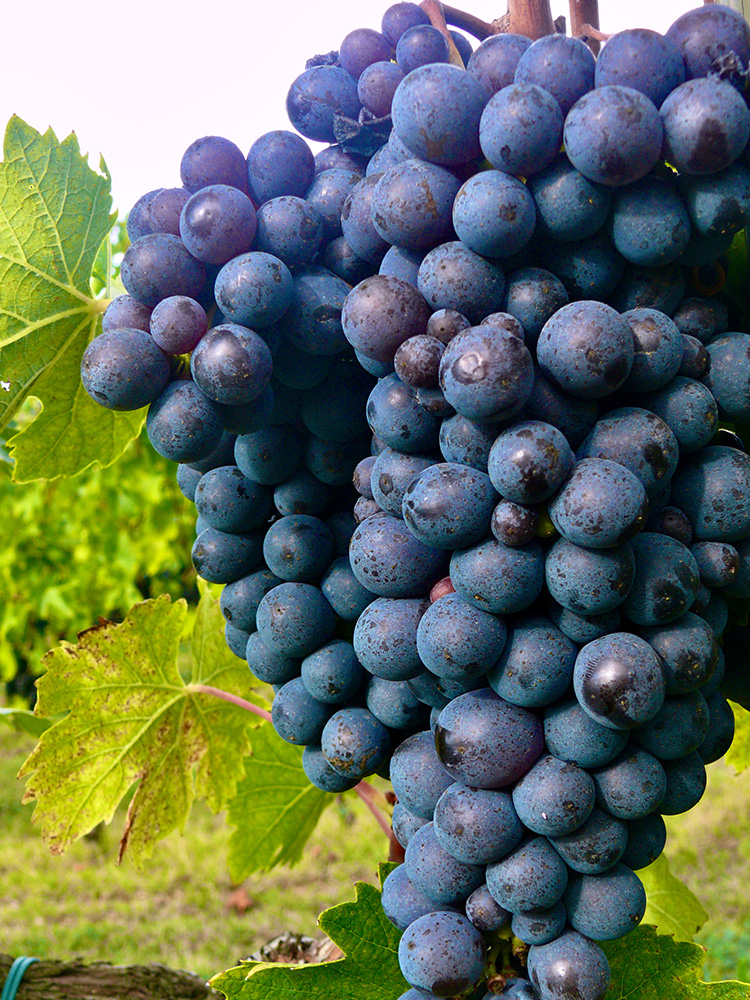

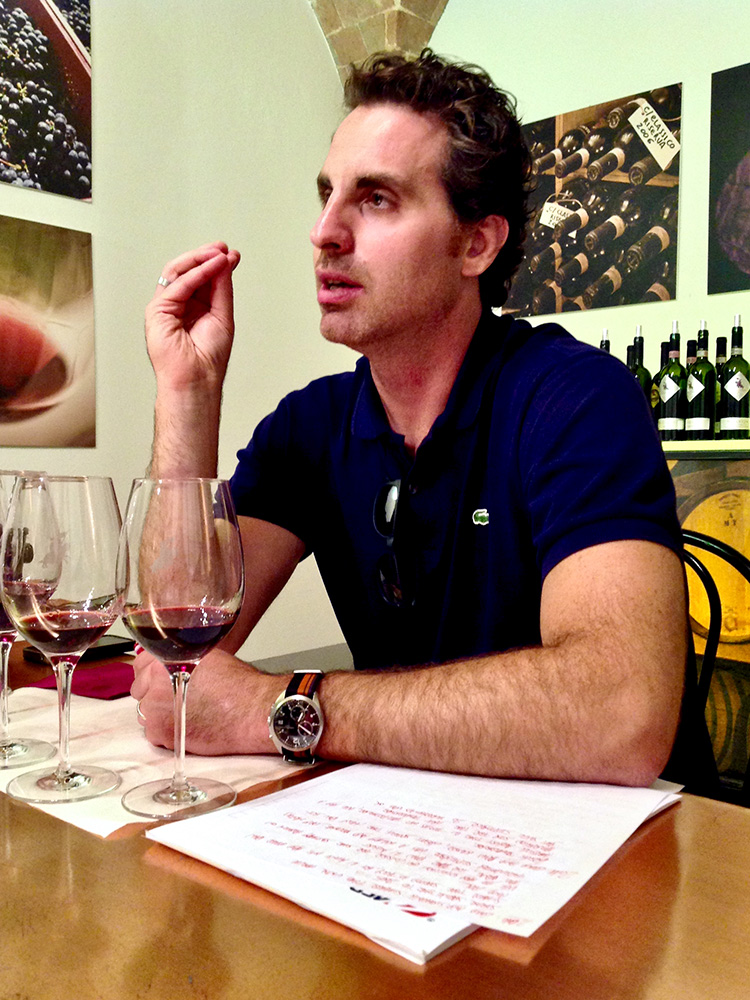
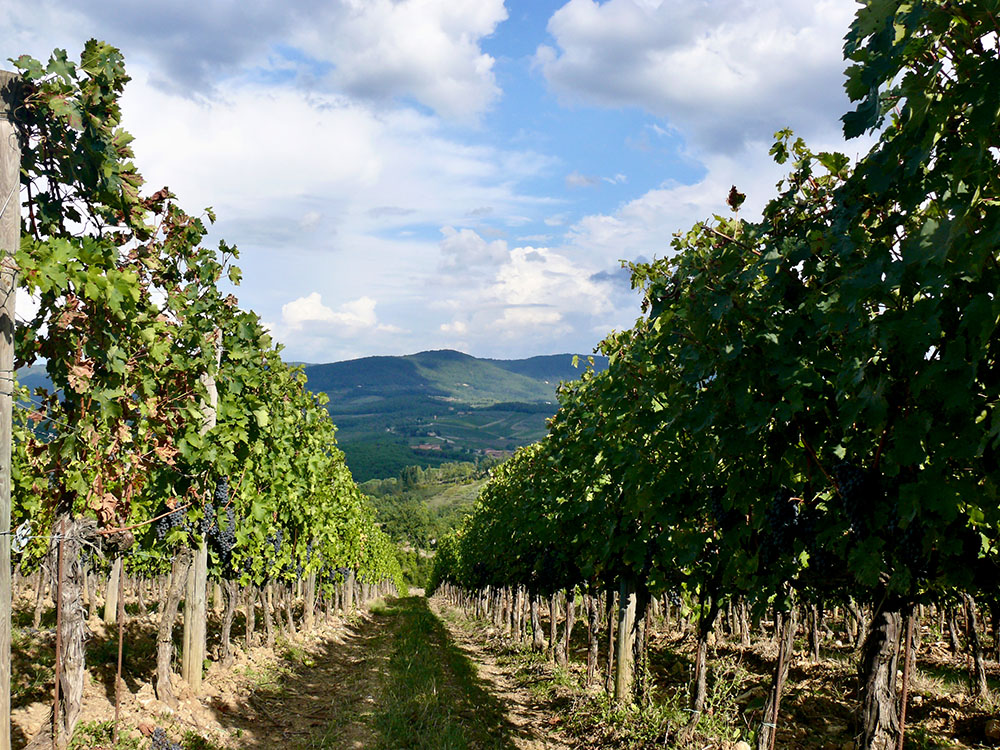
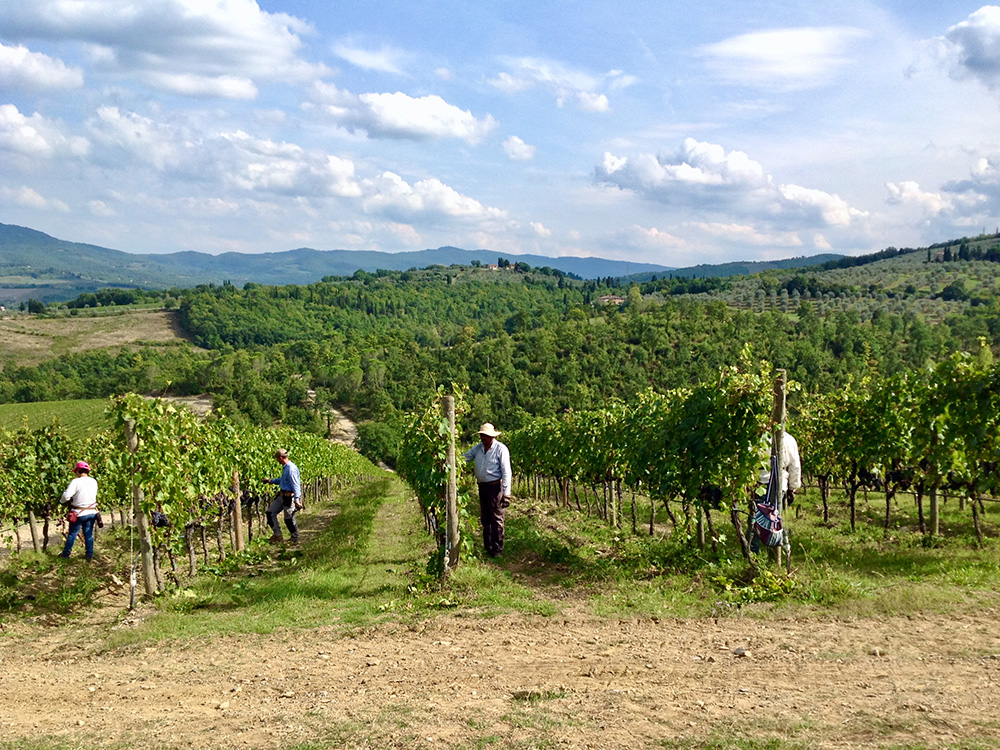
Our small group piled into vans with Federico Berardinelli, the chef from il Cavaliere. Our destination was Florence, and the excursion was the first in a series of efforts that would culminate in lunch on Gabbiano’s terrace.
The menu was unscripted, so we would see what the market presented us. This is how people cook every day in Florence, and in Rome and Pisa, Mexico City, Istanbul, everywhere. It is not how my mother cooked, but it is how her grandmother cooked, and so on back to my twelfth-great grandmother in a village in the Central Loire called Faye-la-Vineuse.
I was silent as the car slipped through the narrow streets of Florence. I’d lived here, long ago, as a junior in college studying Florentine Renaissance art. Florence was an enchantment then, but I’d not been back in thirty years, and it was now an ambering memory. Here it was in full color. I wanted to cry Stop the car! To get out and wander, to see if I could still recognize the city and myself within it.
Berardinelli was taking us to Mercato Sant’Ambrogio, one of Florence’s two large food halls. I was more familiar with the other one, Mercato Centrale, a two-story, iron and glass structure that first opened in 1874. When I lived here as a starving twenty-year-old it was Centrale I haunted. Back then its first floor was dedicated to meat, dairy, and produce, its second to dry goods and pantry staples. Today it is a tourist draw, while Sant’Ambrogio retains more of its workday aesthetic. This was why Berardinelli was taking us to Sant’Ambrogio.


I was vegetarian when I lived in Florence, poor, inhabiting a spare, shared bedroom in a pensione near the Arno that supplied breakfast only and not much of it. I stretched my lunch budget buying pizza from a window or eating with local workers at a caffeteria. For dinner I would skimp, just primo and contorno at a trattoria. No wine, or a just little, a jug on the table shared among fellow students. I wish I had a time machine so I could taste that wine again, knowing what I know now.
Sometimes for lunch I would venture to Mercato Centrale and buy a bag of mixed greens, a piece of cheese, a loaf of bread, and a lemon. Returning to my room I would dump the greens into a big plastic bowl, wring out the citrus and drizzle it all with cloudy oil. I’d take my lunch seated cross-legged on the parquet floor, tearing hunks of bread to sop the juice. On fair days I kept the window open to the view of the green Arno, spring sounds of river and street filtering in.
I often visited the Mercato just to look. My interest in food had recently dawned. I’d taught myself to cook by banging together meals at a campus house I shared with others, and I’d spent part of the winter before Florence working in a stone-cold catering kitchen in South London. I’d grown up omnivorous, but recent vegetarianism had given me fresh eyes through with to see meat. At the market I regarded the displays of beef, poultry, and fish with a mix of fascination and faint revulsion. They were so unlike the supermarkets of my youth, with their products sanitized past recognition. These displays seemed to celebrate meat’s animalness: poultry with heads and feet intact, whole suckling pigs, fish with eyes that no longer see.
And there were organ meats. These were never part of my family’s dinner rotation, although my mother had eaten them during the Depression. In Florence I’d formed a particular aversion to tripe after encounters on the streets with steaming pushcarts vending trippa and lampredotto sandwiches. I’m sure they are delicious to those for whom they were, as a child, a special treat. But I found the smell abhorrent and would cross the street to avoid it.
On the ride in with the chef we passed one of these vendors. Oh, my, I’d said quietly, sucking air through my teeth. Streetcart tripe.
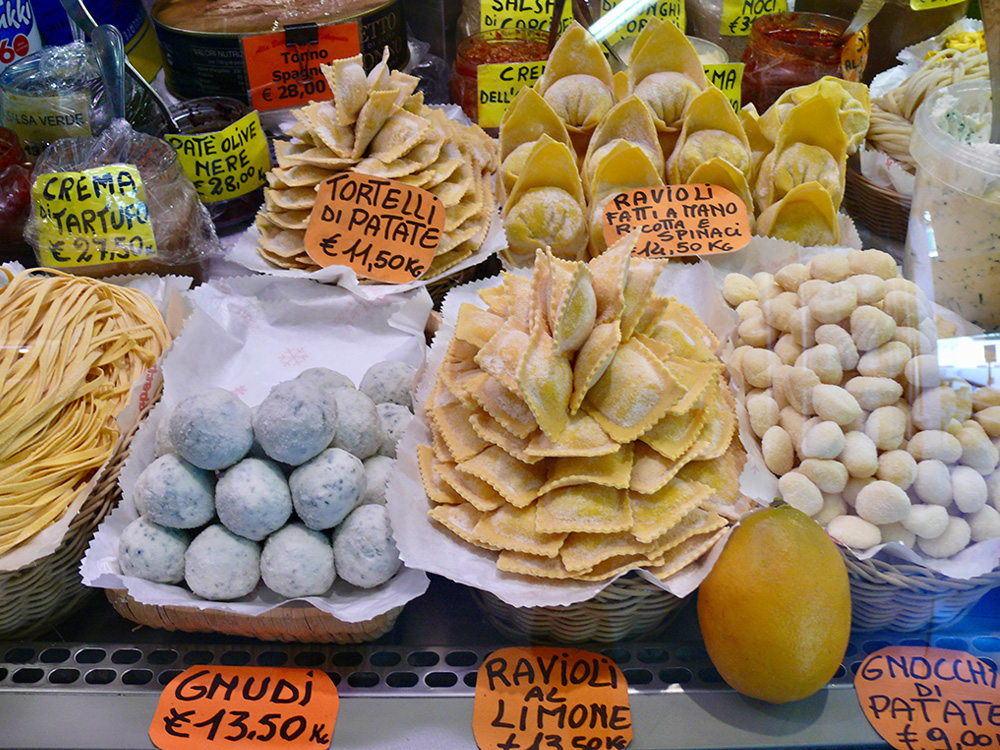
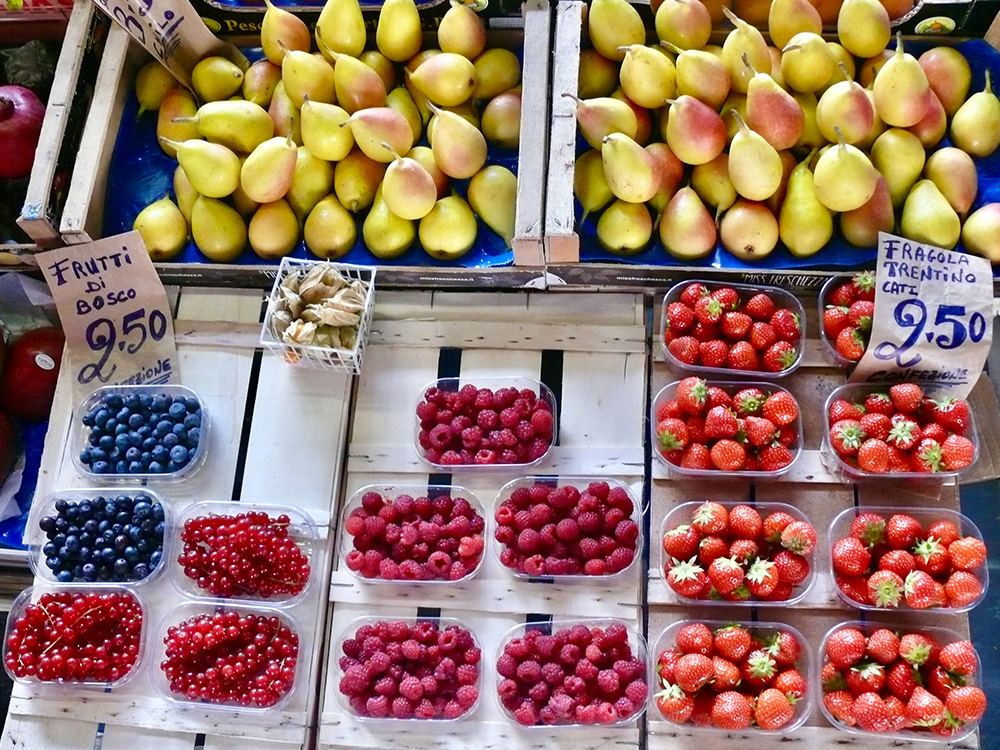
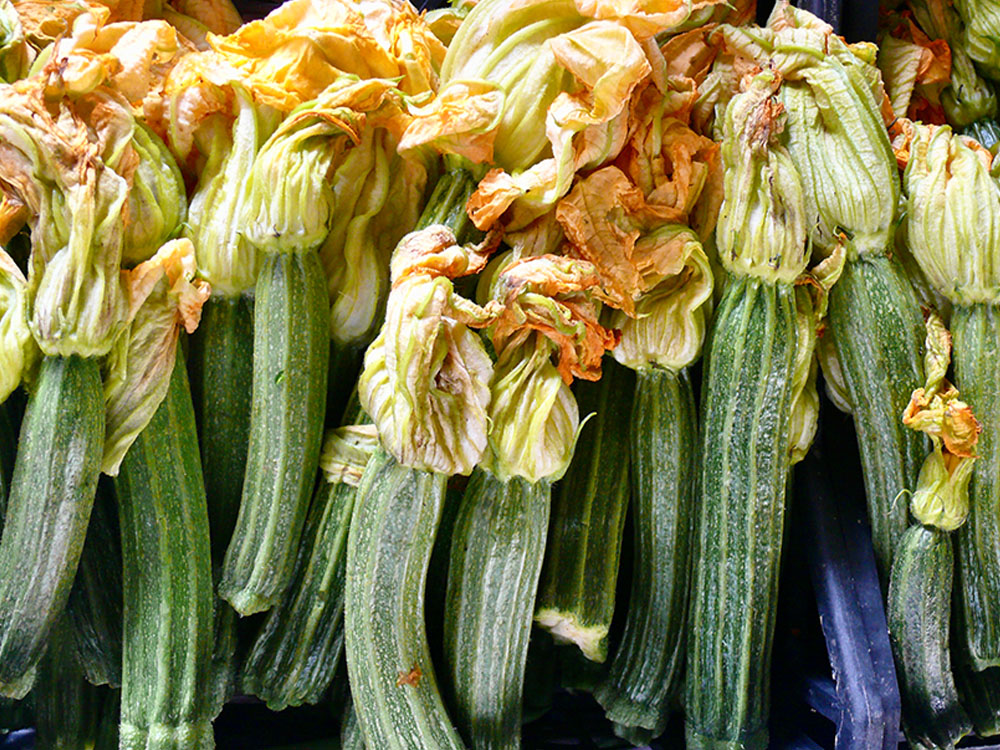


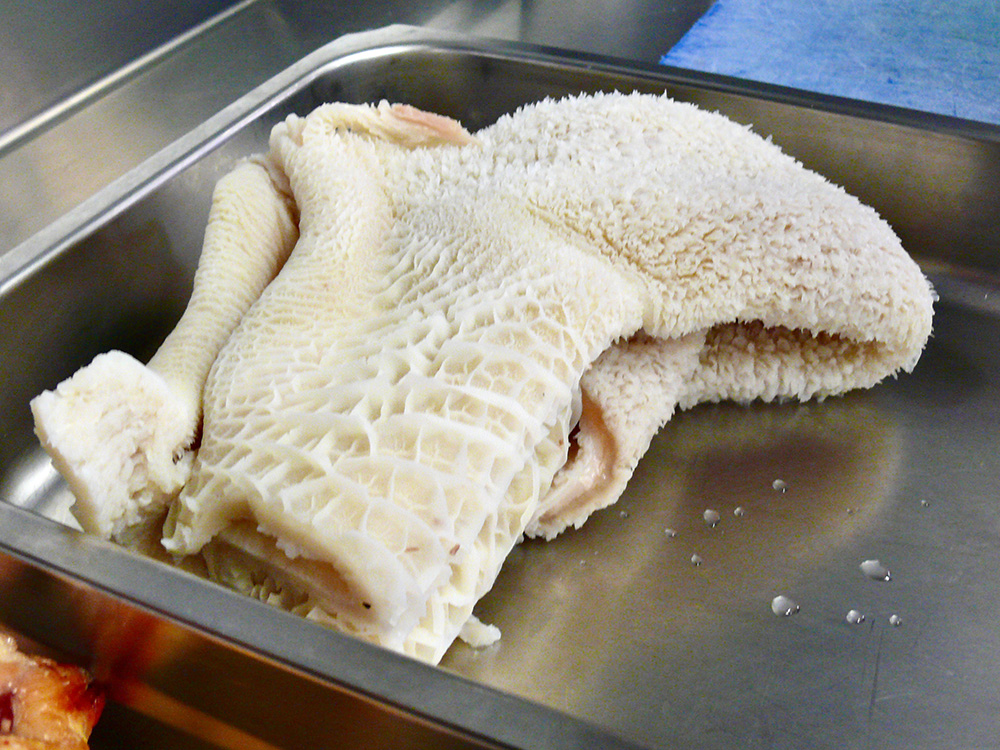
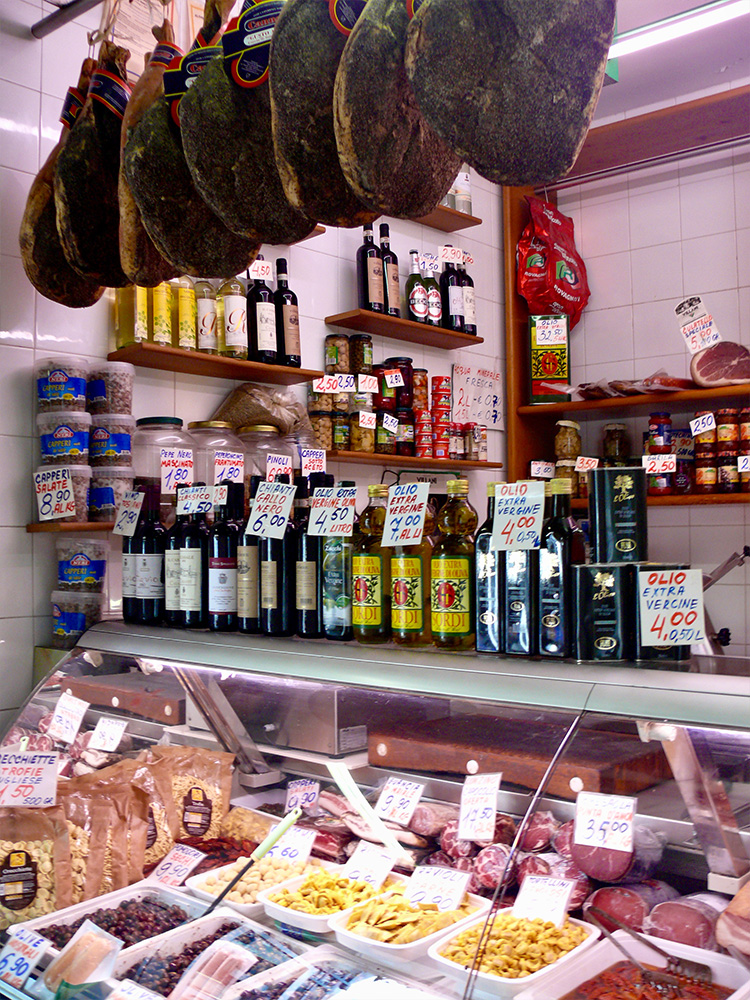
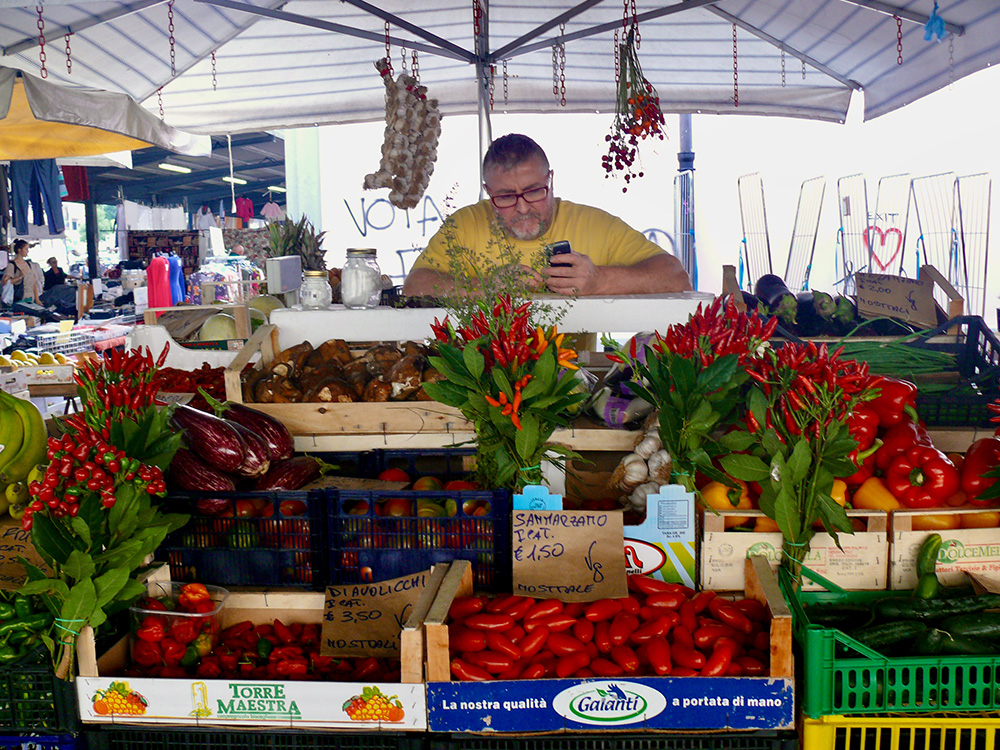
The car emptied us into the streets of Florence, my shoes on the pavement at last. We entered the market and my colleagues beetled around the chef as he began to source ingredients. I broke off to wander around, looking and inhaling and listening to the music of Italian being spoken toward the most mundane of ends: buying foods for the family lunch. I read aloud the names of the vegetables, fruits, cheeses, meats, to see what the words felt like in my mouth: porcini, rapini, melanzana, pesce, fica, tartufo, calamari. They felt boisterous, glittery, stranieri. I cruised past some tripe, but rather than flinching, this time I looked it in the eye.
Provisions in hand, we reconvened to the van for the half-hour ride back to the castle. Someone asked Berardinelli about his training and career. He told us he had owned a restaurant in Florence, south of the river, in the Oltrarno, and that he’d also consulted. He’d been cooking a long time.
“Where do you get your ideas?” I asked.
“Well, in Florence, it’s impossible to cook any way other than the classics,” he said, “which is what diners and tourists expect. That’s why we don’t have any young chefs.”
“Tradition stifles innovation?”
“In Italy it’s difficult to get a Michelin star, because you need a strong story on your back. You need to stand out. Do you know any famous Italian chefs? The famous chefs are all in America.”
“What does inspire you, then?” I asked.
“My inspiration comes from local people and local markets. I look to the people for that. I don’t often go to restaurants. I don’t look at other chefs. Because I don’t want to compete with them. If you’re competing, you’ll never be Number One. You’ll always be Number Two, Number Three. Why would you want that?”
Back in the restaurant’s small, orderly kitchen, the chef and his sous unpacked the goods and laid them onto steel trays for washing and prep. We had lobed Florentine tomatoes, torpedo onions, Tuscan beans, two whole ducks, pork sausage, fennel, and, yes, tripe.
He put us to work. One person to shell beans. Another to pull sausage meat from its casing and knead it with bread soaked in milk. I put my camera down as chef looked straight at me. Tripe, his eyes said, more command than question. He must have sensed I needed this test: The test of tripa, how tripa feels in my hand, my mouth, how it tastes. What it means.
He pulled the glistering, snow-white veal stomach from the tray and laid it on a cutting board. I drew a breath, washed my hands, dried them on my black apron, and approached the station.

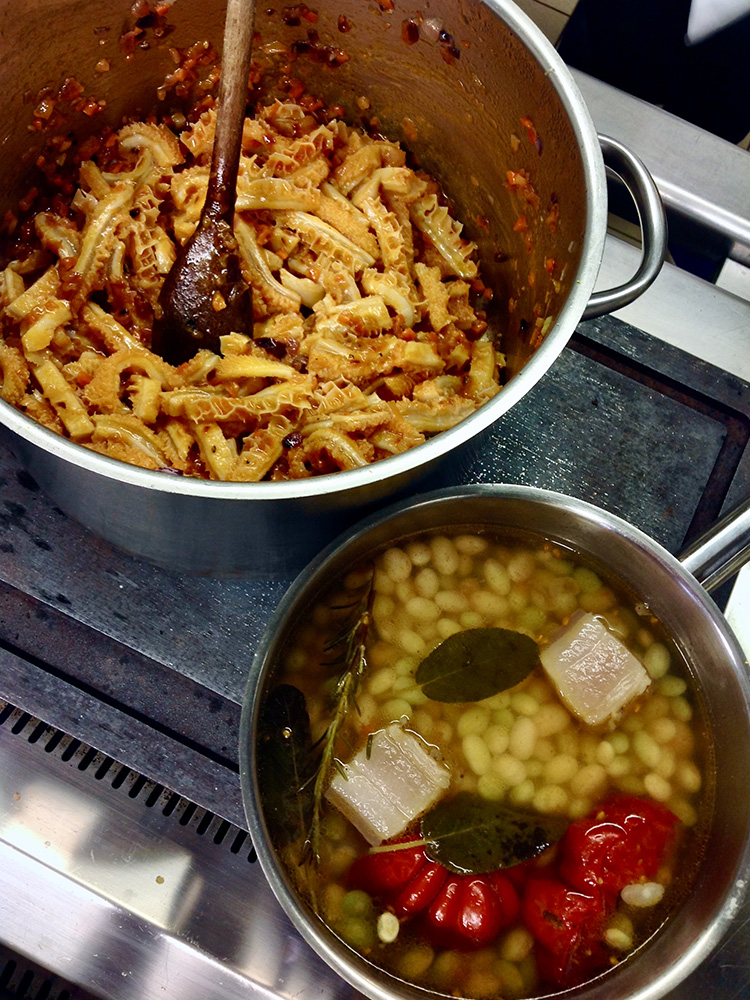

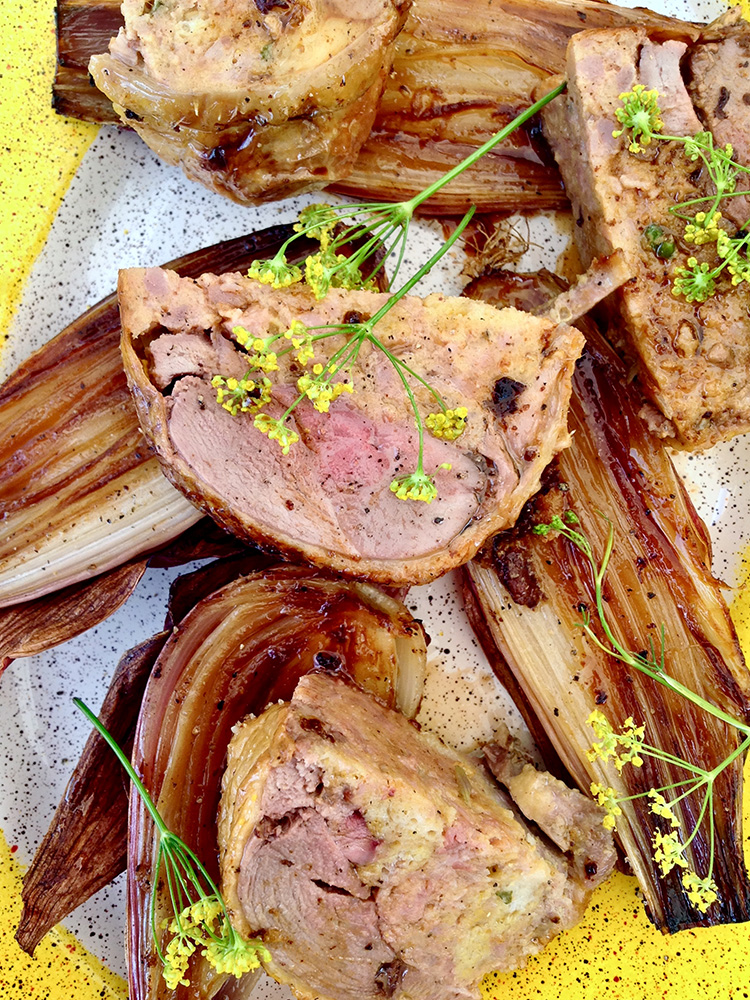
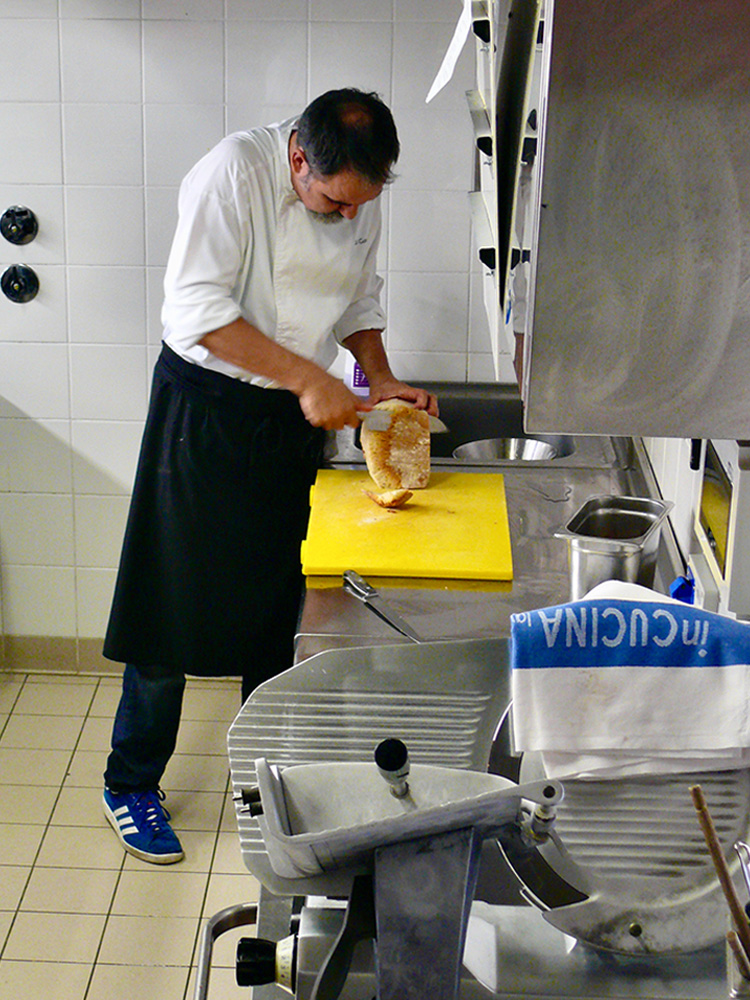
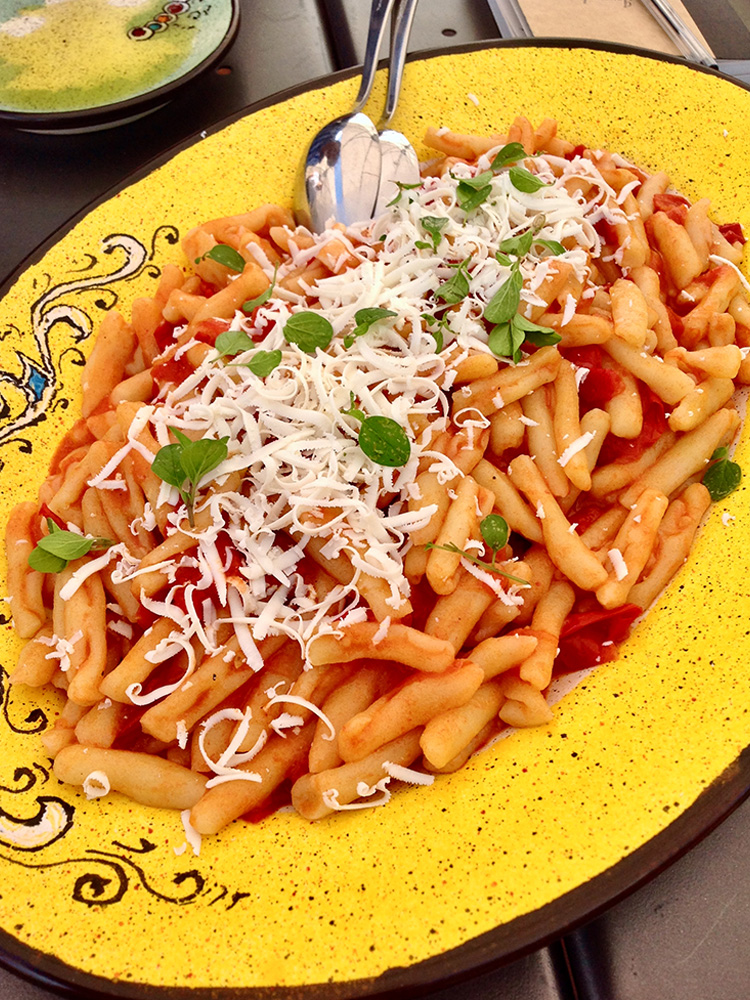
It didn’t make sense to me that the intricacies of the tissue would be on the outside of the stomach. He confirmed that, yes, it was sold inside-out so you could evaluate its texture. He had selected this one because it had the most regular honeycomb, and because it was pure white. With a sharp knife, he showed me how he wanted it cut, across first, then into strips.
It sat before me like a rubbery bag, refusing to lie flat. Carving this would be a topological exercise. I put my left hand on the tripe as my right hand worked the blade. It was springy and pliant. It wasn’t slippery. It did not smell. I started sectioning it into pieces across the grain, although I had no idea what we would be doing with it. Braise it? Sear it? Did it, like the boar, need to boil for a day?
The chef left to bone the ducks and stuff them with sausage dressing. Then he trussed and roasted them with the red torpedo onions. He took my strips of tripe and sautéed them with soffritto, letting it simmer to tenderize before adding fresh tomatoes.
The duck was carved, the lunch was served. We sat to eat. It was 3 p.m.
The tripe was — edible. It was mild, almost neutral, more texture than flavor. I took four small pieces and ate three. Three were plenty, for a first time.
It all worked with the wine. Of course it did.
Wine is a system in motion. Food, too. The Etruscans plucked grapes from trees and today we rattle them off the vines with noisy machines. A Florentine family built a fortress and vineyard and today it’s owned by a global conglomerate. I rarely drank wine and now I’m part of its global conversation. I was a vegetarian for years yet there I was, eating tripe.
Wine gets made, wine gets drunk. The river swells and dries over seasons, centuries, millennia, but it keeps flowing.
I’m grateful to Treasury Wine Estates for sponsoring my travel, accommodation, and meals; all wines were samples for review.

